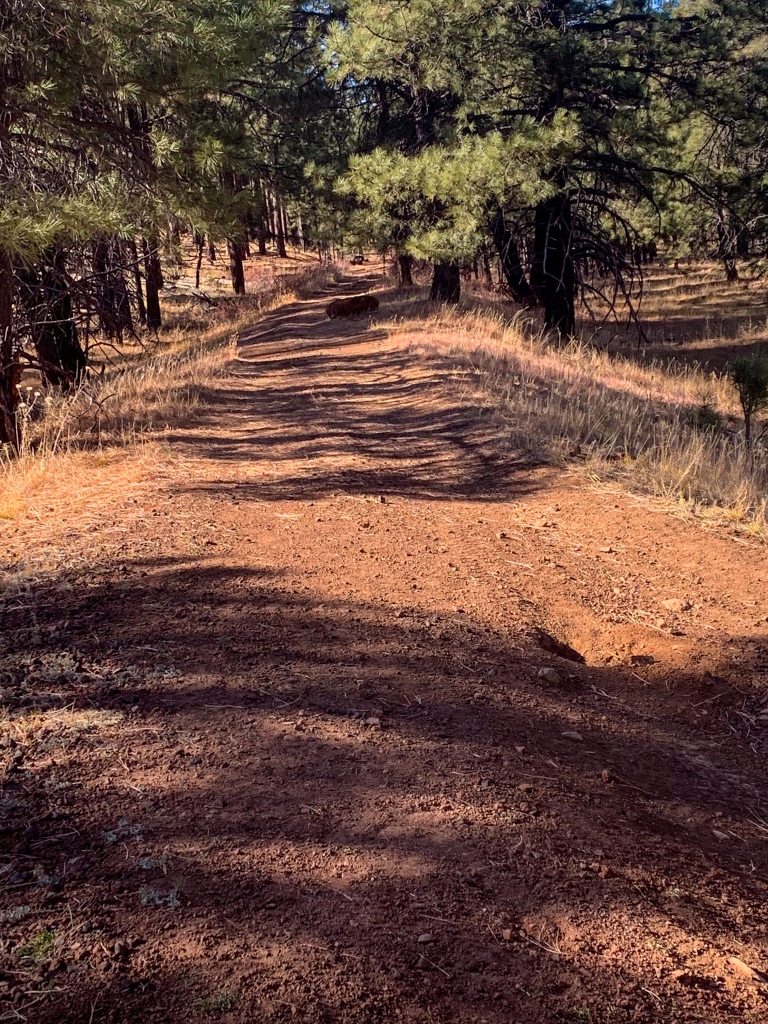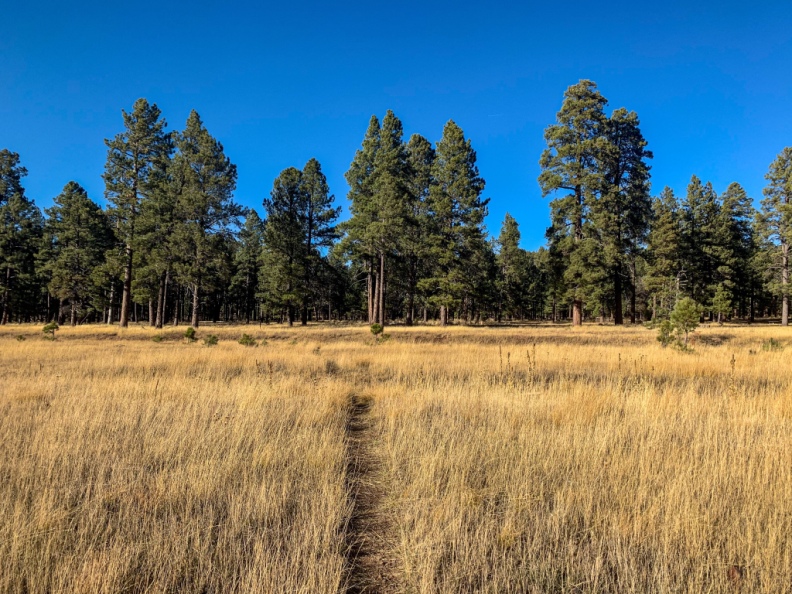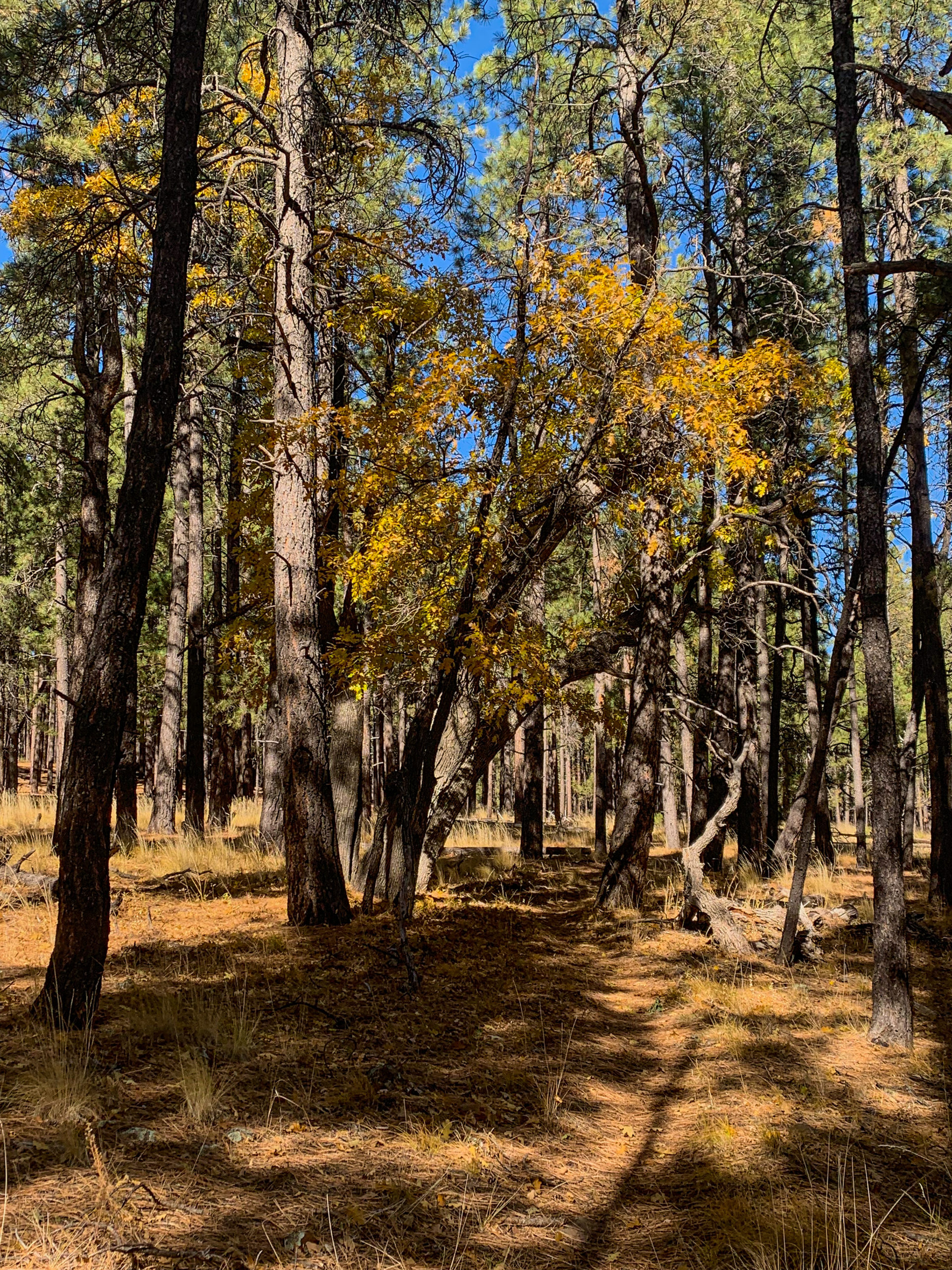Backpacking the Arizona Trail: Passages 29 & 29 (Mormon Lake & Happy Jack)
AZT Thruhike, Day 34
Trans-Arizona/Utah Hike, Day 41
In the land of Arizona
Through desert heat or snow
Winds a trail for folks to follow
From Utah to Old Mexico
It’s the Arizona Trail
A pathway through the great Southwest
A diverse track through wood and stone
Your spirit it will test
Oh, sure you’ll sweat and blister
You’ll feel the miles every day
You’ll shiver at the loneliness
Your feet and seat will pay
But you’ll see moonlight on the borderlands
You’ll see stars on the Mogollon
You’ll feel the warmth of winter sun
And be thrilled straight through to bone
The aches and pains will fade away
You’ll feel renewed and whole
You’ll never be the same again
With Arizona in your soul
Along the Arizona Trail
A reverence and peace you’ll know
Through deserts, canyons, and mountains
From Utah to Old Mexico
-“The Arizona Trail,” Dale R. Shewalter
Navajo Spring-Alvin Teague Memorial
After spending yesterday on a zero in the town of Mormon Lake, it’s brutally cold this morning, notably because of the strong wind that whips across the clearing to the west. Not setting up the tent last night was a mistake. I ultimately fill up for the last time at Navajo Spring and run into a few dayhikers who have completed over 300 miles of the trail themselves. Two of them are the Grouper and the Oracle. I continue south, aiming for Gooseberry Springs TH and Passage 29, Happy Jack.

Arizona Trail, Passage 30, Mormon Lake
Coconino National Forest

Arizona Trail, Passage 30, Mormon Lake
Coconino National Forest

Arizona Trail, Passage 30, Mormon Lake
Coconino National Forest

Arizona Trail, Passage 30, Mormon Lake
Coconino National Forest

Arizona Trail, Passage 30, Mormon Lake
Coconino National Forest
Alvin Teague Memorial-Van Deren Spring
The trail continues to pass evidence of the logging railroads that it follows in the area, particularly in the form of the grades that emerge. There is a memorial to someone by the name of Alvin Teague, adorned with horseshoes, atop one such grade. This seemed random at the time I passed, but such things rarely are, so I looked him up afterwards; apparently he was a World War II veteran who went on to work for the Forest Service for 34 years.

Arizona Trail, Passage 30, Mormon Lake
Coconino National Forest

Arizona Trail, Passage 30, Mormon Lake
Coconino National Forest

Arizona Trail, Passage 30, Mormon Lake
Coconino National Forest

grade (Alvin Teague Memorial in center) while backpacking the AZT
Arizona Trail, Passage 30, Mormon Lake
Coconino National Forest
But railroad grades arent the only evidence of the past – at one area of rock outcrops where I stop to rest for a while, I find an immense collection of railroad artifacts. Please remember that all such items are protected by the Antiquities Act as part of our shared American heritage, so please leave them for others to enjoy as you do.



Arizona Trail, Passage 30, Mormon Lake
Coconino National Forest
Van Deren Spring-Gooseberry Springs Trailhead
The trail passes Van Deren Spring – which, if it is what I thought it was, looked little more than a mudpit at present. Continuing on, the trail crosses Lake Mary Road once again and enters the Mogollon Rim District of the Coconino National Forest at a gate. It is 20 miles to the Blue Ridge Reservoir from this point, though I am not sure if that signage accounts for the new reroute that I know is coming up on this stretch.

Arizona Trail, Passage 30, Mormon Lake
Coconino National Forest

AZT, Passage 30, Mormon Lake
Coconino National Forest

AZT, Passage 30, Mormon Lake
Coconino National Forest

AZT, Passage 30, Mormon Lake
Coconino National Forest
Arizona Trail, Passage 30, Mormon Lake
Coconino National Forest
Arizona Trail, Passage 30, Mormon Lake
Coconino National Forest

AZT, Passage 30, Mormon Lake
Coconino National Forest
Arizona Trail: Passage 29 (Happy Jack)
Gooseberry Springs-Shuff Tank
I arrive at Gooseberry Springs in the late afternoon. The trailhead has some great interpretive signage about the railroad and logging history in the area. Then it’s back into the ponderosas again.
The first stretch is similar to the area just finished; then, the trail takes a break from its meadow jaunts and decides to work in a hill, winding through a thicker forest and passing large ferns, reminders of how cold and wet the prior spring was, before one of the driest summers in northern Arizona recorded history dried them out. The trail passes Maxie Tank, then continues through flatter ponderosa terrain and rice grass meadows to Shuff Tank. I stop slightly beyond Shuff Tank for the evening as the sun sets.

AZT, Passage 30, Mormon Lake
Coconino National Forest

AZT, Passage 30, Mormon Lake
Coconino National Forest

AZT, Passage 30, Mormon Lake
Coconino National Forest

Coconino National Forest

AZT, Passage 30, Mormon Lake
Coconino National Forest

Coconino National Forest

AZT, Passage 30, Mormon Lake
Coconino National Forest

AZT, Passage 30, Mormon Lake
Coconino National Forest

AZT, Passage 30, Mormon Lake
Coconino National Forest

AZT, Passage 30, Mormon Lake
Coconino National Forest

AZT, Passage 30, Mormon Lake
Coconino National Forest

AZT, Passage 30, Mormon Lake
Coconino National Forest
Arizona Trail: Passages 28-29 Logistics
| Passage 29 (Mormon Lake) | Passage 28 (Happy Jack) | |
| Trail Map & Passage Page from AZTA | Passage 29 (Mormon Lake) | Passage 28 (Happy Jack) |
| Trail Surface | Dirt singletrack | Dirt singletrack |
| Length (Mi) | 14.8 | 29.4 |
| Season | Spring-Fall | Spring-Fall |
| Potential Water Sources | Mayflower Springs (mi 247.8 SOBO/540.9 NOBO) Dairy Springs (mi 248.9 SOBO/539.8 NOBO) Double Springs (mi 250.6 SOBO/538.1 NOBO) Wallace Spring (mi 252.3 SOBO/536.4 NOBO) Indian Springs (mi 255.0 SOBO/533.7 NOBO) Mormon Lake Village (mi 255.0 SOBO/533.7 NOBO) Spring/Tank (mi 257.6 SOBO/531.1 NOBO) Van Deren Spring (mi 261.3 SOBO/527.4 NOBO) Allan Lake Tank (mi 262 SOBO/526.7 NOBO) | Maxie Tank (mi 265.2 SOBO/540.9 NOBO) Shuff Tank/FR 135D (mi 266.7 SOBO/539.8 NOBO) Bargaman Park Tank (mi 270.7 SOBO/538.1 NOBO) Pine Spring (mi 271.5 SOBO/536.4 NOBO), off trail Wild Horse Tank (mi 274.2 SOBO/533.7 NOBO) Dave’s Tank (mi 277.3 SOBO/533.7 NOBO), off trail Gonzalez Tank (mi 279.3 SOBO/531.1 NOBO), off trail Foot in Tree Tank (mi 281.5 SOBO/527.4 NOBO) Homestead Tank (mi 284.3 SOBO/526.7 NOBO) Sheepherders Tank (mi 285.2 SOBO/526.7 NOBO), off trail Wochner Tank (mi 285.5 SOBO/526.7 NOBO) Hay Meadow Tank (mi 291.5 SOBO/526.7 NOBO) Blue Ridge Ranger Station, Forest Service (mi 292 SOBO/526.7 NOBO), off trail |
| Trailheads | North: Mayflower Spring (mi 247.8 SOBO, 540.9 NOBO) South: Gooseberry Springs Trailhead (mi 262.6 SOBO/526.1 NOBO) | North: Gooseberry Springs Trailhead (mi 262.6 SOBO/526.1 NOBO) South: Blue Ridge Trailhead (mi 292.1 SOBO, 496.7 NOBO) |
| Trailhead Access | North: Two track dirt road South: Graded dirt road | North: Graded dirt road South: |
| Wilderness | No | No |
| Possible resupply points | Mormon Lake village | None |
| Difficulty | Moderate | Moderate |
| Potential campsites (mileages S to N) | Dairy Springs Campground Double Springs Campground Indian Springs – excellent spot, wide flat camping area at the junction of the Indian Springs Trail to the village of Mormon Lake and the Arizona Trail Numerous spots south of Mormon Lake as terrain flattens | Various LNT-compatible locations throughout |
| Threats | Heat – wear a cotton shirt so you can soak it. Synthetics aren’t great in the desert. Hypothermia – nights are generally about 30°F cooler than days in Arizona regardless of the time of year. Consider this in packing gear. Mornings can be cool year-round. Hyponatremia – “drunk on water.” To avoid, ensure adequate salt & electrolyte intake and ensure you eat as well as drink water. Symptoms are almost identical to dehydration, but drinking more makes it worse. Prevention is by far the best solution. Dehydration Lightning | Heat – wear a cotton shirt so you can soak it. Synthetics aren’t great in the desert. Hypothermia – nights are generally about 30°F cooler than days in Arizona regardless of the time of year. Consider this in packing gear. Mornings can be cool year-round. Hyponatremia – “drunk on water.” To avoid, ensure adequate salt & electrolyte intake and ensure you eat as well as drink water. Symptoms are almost identical to dehydration, but drinking more makes it worse. Prevention is by far the best solution. Dehydration Lightning |
| Permits Required? | No | No |
| Cell service? | Limited | Limited |
| Ecosystems traversed | Rocky Mountain Montane Conifer Woodland | Rocky Mountain Montane Conifer Woodland |
| Highlights | Mormon Lake Mormon Lake village Railroad history Largest ponderosa forest in world | Largest ponderosa forest in world |
| Rocky Mountain Montane Conifer Woodland | |
| Common Trees/Shrubs | * Ponderosa Pine * Southwestern white pine * Subalpine fir * White fir * Rocky Mountain maple * Bigtooth maple * Grey alder * Red birch * Red osier dogwood * Cliffbush * Mallow ninebark * New Mexican locust * huckleberry * bilberries |
| Common herbaceous plants | * fringed brome * Geyer’s sedge/elk sedge * Ross’ sedge * Bronze sedge/dry land sedge/hillside sedge/hay sedge/Fernald’s hay sedge * screwleaf muhly * bluebunch wheatgrass * Spruce-fir fleabane * wild strawberry/Virginia strawberry * Small-flowered woodrush * mountain sweet Cicely * bittercress ragwort * western meadow-rue * Fendler’s meadow-rue |
